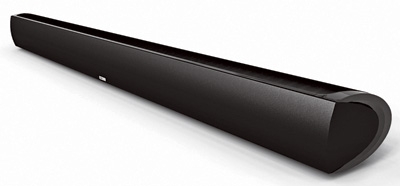7 Soundbars; Simple to Luxe Page 5

If your flat-panel TV is beautifully styled, then it makes sense to mate it with a beautiful soundbar. The Polk SurroundBar 50 is as stylish as they come. Its black, brushed-aluminum cabinet is quite handsome, and its slender profile can make even the flattest panel look thick. Throw in a tasteful, wraparound cloth grille, and you've got style points to spare.
The 50 is a "pure" soundbar - which means it's completely passive, containing only speakers. You won't find any amps, decoders, virtual surround, or subwoofer here. But arrayed across the front panel, you will find nine identical drivers, three matching tweeters, and two ports. Your system's upstream electronics, amplification, and powered subwoofer remain the same; the soundbar is an all-in-one drop-in replacement for all five satellite speakers found in a standard home theater.
Setup The 50 comes with a number of plastic mounting pieces. You get two pairs of cradles that prop up each end, as well as a larger plastic bracket, a metal plate, and the necessary screws for wall mounting. Polk also kindly throws in a 15-foot length of flat, 10-conductor speaker cable with each wire pair labeled at both ends. This makes hook-up pretty straightforward.
| Price $1,100 / polkaudio.com / 888-869-4375 |
| •(9) 3.5-in composite woofers; (3) 0.75-in silk-dome tweeters •Finish: black •51 x 4.5 x 5.25 in; 15 lb |
The 50 has ten binding posts aligned across its back surface, one pair for each of the five channels it reproduces. Conveniently, the posts are color-coded to match the supplied speaker cable. Using a pair of cradles, I placed the soundbar under my TV and then disconnected the satellite cables from the back of my receiver so I could wire up the 50 instead.
Following Polk's instructions, I set all of my receiver's channels to "small." I left my own subwoofer connected to the receiver's sub output, with a 120-Hz crossover frequency. I alternately turned my sub level up and down, to get a better idea of the extent of the 50's bass response. Again following Polk's advice, I set my receiver's delay times according to my distance away from the soundbar, with all channel delays set equally. But during my audition, I added some delay to the surround channels, which seemed to slightly open up the soundfield. Finally, I set the front levels to 0 dB and the surround levels to +3 dB.
Music Performance I was expecting characteristically great Polk sound, and the 50 didn't disappoint me. Kashmir's albums were faithfully reproduced, with a dynamic, although somewhat bright sound. Vocals and instrumentals were spotlessly clean in the upper midrange. Higher up, the hi-hat and cymbals were either slightly edgy or refreshingly brisk, depending on your point of view. Of course, all the bass reproduction was courtesy of my own subwoofer. But the 50 did have sufficient lower midrange to create a nice blend with the sub. Potentially problematic "gap" instruments like bass guitar were nicely supported by the soundbar.
Similarly, Blue Man Group came across nicely. Vocals were clean and percussion snappy. A good deal of the synth lines tested the soundbar's lower midrange, where I could have used a little more warmth here, but I was still satisfied. Of course, the surround channels were collapsed into the front, but aside from the downmixing, musical fidelity was not an issue.
Movie Performance The aggressive collection of effects on Superman Returns really helps punctuate the movie's action, with some placed hard in specific channels and others panned across channels to correspond to onscreen visuals. The SurroundBar 50 reproduced all of these (as well as dialogue and score) with great transparency, but it couldn't really produce spatial fidelity from the film's surround information. The perceived sources of the five channels remained stubbornly planted at the soundbar, and without interchannel phase games or virtual surround processing, there was nothing to induce my brain to decide otherwise. Clearly, a consolidated soundfield isn't as immersive as one distributed by separate speakers, but I quickly grew accustomed to it. The convenience of soundbars does have limitations - as with several of the other bars, the essential fidelity of the Polk's playback largely compensated for the lack of genuine surround sound.
Bottom Line Imagine taking all of your satellite speakers and lining them up under your display - that approximates what the SoundBar 50 does. Unlike some other soundbars, it's not an all-in-one solution but rather requires the decoding, amplification, and subwoofer of a traditional playback system. And while it wasn't terribly convincing in its reproduction of the surround channels, it is, in most other respects, simply a complete set of good satellite speakers in one box. Its straightforward design and sound quality let it stand on its own.
- Log in or register to post comments




















































